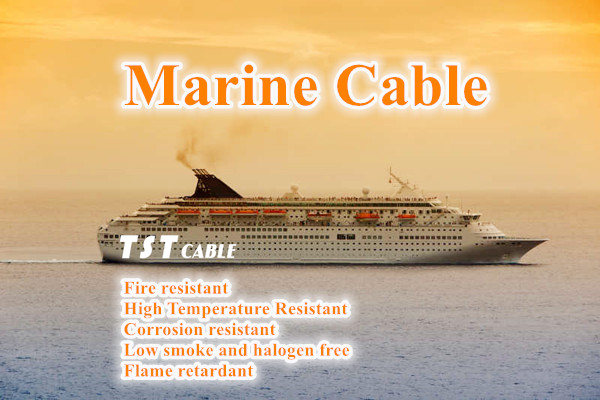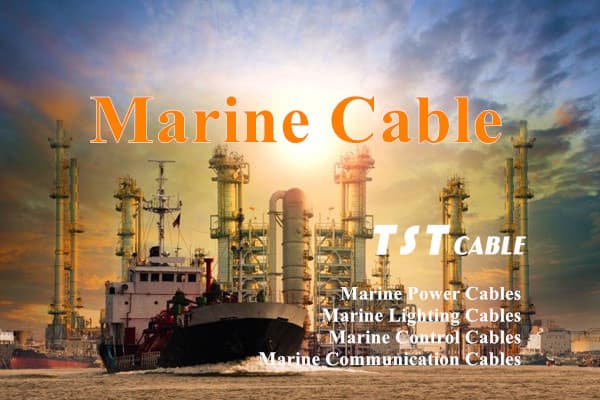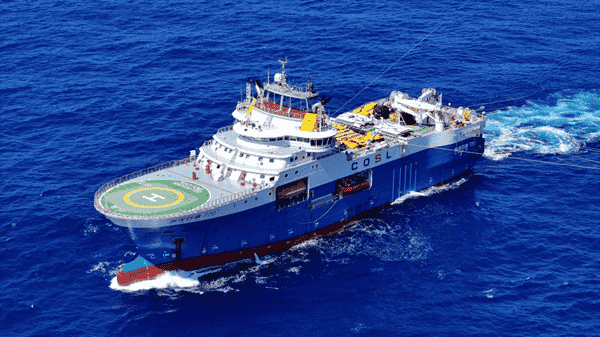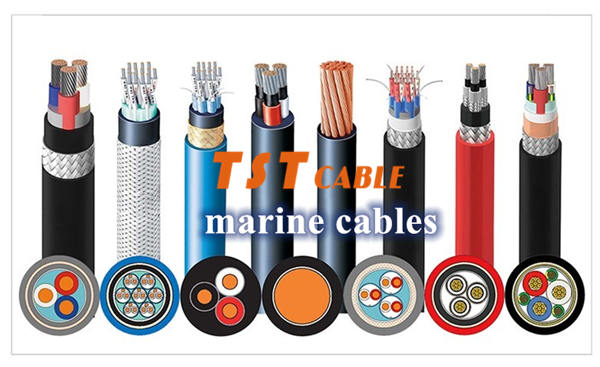
Introduction to Marine Cables
Marine cables are wires and cables used for power, lighting and control of hosts in various ships and offshore oil platforms and other buildings on the water. Marine cables are different from ordinary cables, due to the use of special working conditions in the environment, marine cables in the technology and material requirements than ordinary cables. With the development of the shipping industry, marine cables from ordinary cables separated from a special cable types, and continue to grow. At present, there are more than ten types of marine cables, tens of thousands of specifications and models. The industry has been exploring its quality and technology in depth. Marine cables represent the height of cable technology, safeguard the safety of ships, and play a key role in ship construction.
Marine cables can be divided into marine power cables (including low voltage power cables with rated voltage AC 1kV and below and medium voltage power cables with rated voltage AC 3-15kV), marine control cables, marine communication cables, marine signal cables and marine RF cables according to the scope of use.
Marine cable structure
Marine cable is mainly composed of conductive core wire, insulation, sheath and armor layer. Among them, the insulation layer is the key structure to reliably isolate the high-voltage electrode from the ground electrode, which needs to withstand the long-term effects of operating voltage and various over-voltages, and at the same time, it can withstand the thermal effects of the heat conductor.
Commonly used marine cable series standards
Our products comply with the main international standards and certificates: ABS,Bureau Veritas, Lloyd’s Register, IEC,UL, CSA,ISO.
IEC 60092-3 standard mainly contains IEC 60092-350 “Ship electrical installations Part 350: Cables for power, control and instrumentation of ships and offshore installations, general structure and test methods”.
IEC 60092-360 “Marine electrical installations Part 360: Insulation and sheathing materials for power, control, instrumentation and communication cables for ships and offshore installations”.
IEC 60092-353 Electrical installations on board ships Part 353: Power cables for rated voltages of 1 kV and 3 kV
IEC 60092-354 “Electrical installations on board ships Part 354: Single-core and multi-core extruded solid insulated power cables for rated voltages from 6 kV (Um = 7.2 kV) to 30 kV (Um = 36 kV)
IEC 60092-376 “Marine electrical installations Part 376: Control and instrumentation circuits 150/250V (300V) cables”.
American Bureau of Shipping (ABS) ABS Rules for Building and Classing Steel Vessels
Bureau Veritas Rules for the Classification of Steel Ships of Bureau Veritas (BV), France
DNVGL-RU-SHIP and other standards formulated after the merger of Det Norske Veritas and German Bureau Veritas.
Characteristics of Marine Cables
Due to the use of harsh environmental conditions, marine cable needs to be safe and reliable, long life, small size, light weight and other characteristics. In addition, it needs to have excellent temperature resistance, fire resistance, flame retardant, oil resistance, moisture resistance, seawater resistance and other properties, as well as excellent electrical and mechanical properties.
Marine cable classification and role
- According to the properties of the ship can be divided into: civilian cables, military cables
- Civilian cable cable varieties and specifications are more abundant.
- military cables in the security and reliability requirements are higher. Compared with civilian cables, military cables are related to national defense and security, protected by law, focusing more on safety, ease of operation and maintenance than the richness of the function, and therefore more varieties and specifications of a single.
- According to the general purpose can be divided into: power cables, control cables, communication cables, lighting cables, etc.
- Main power distribution system: marine cables play a key role in the main power distribution system, they are responsible for the ship’s main generator power transmission to the various sub-panels, and then distributed to the ship’s various power equipment.
- Power system: In the power system of the ship, marine cables are used to connect the engines, generators, propellers and other key equipments to ensure the stable supply of power.
- Lighting system: Marine cables are used to provide power for the ship’s lighting system, including navigation lights, signal lights, internal lighting, etc., to ensure that the ship’s lighting needs are met in various environments.
- Navigation system: Navigation equipments such as radar, GPS, electronic charts, etc. need power support, and marine cables are responsible for providing stable and reliable power and data transmission for these equipments.
- Communication system: Communication equipments on the ship, such as radio, satellite communication system, etc., rely on marine cables for power supply and signal transmission to ensure unobstructed communication between the ship and land or other ships.
- Safety system: including fire alarm system, emergency lighting, life-saving equipment, etc., the normal operation of these systems can not be separated from the support of marine cables.
- Automation and control system: modern ships are highly automated, all kinds of automation equipments and control systems need to send data transmission and control signals through cables.
- Shipboard equipment and auxiliary systems: such as cargo handling equipment, air conditioning and ventilation systems, fresh water generation systems, etc., which all need cables to provide power and control.
- Living electricity: the power supply of the crew’s living area, including galley equipment, entertainment systems, living lighting, etc., are also realized by marine cables.
- According to the insulation material can be divided into: rubber insulation material cable, PVC material cable, cross-linked polyethylene insulation material cable
- rubber has excellent elasticity, tensile strength, elongation, abrasion resistance, tear resistance and compression permanent deformation properties, good electrical insulation, but oil resistance, weather resistance, ozone resistance is poor, resistance to acid and alkali corrosion ability is low; heat resistance is not high, not for work above 100 ℃.
- polyvinyl chloride is the most widely used, but polyvinyl chloride contains halogens, wire and cable accidents will release toxic gases when burned, seriously polluting the environment and affect the rescue.
- cross-linked polyethylene for the best alternative to polyvinyl chloride, known as “green” insulation materials, combustion does not produce harmful substances, flame retardants do not contain halogen, the daily operation of the process does not emit toxic gases.
Their roles are:
Marine power cable: used in the river and sea many kinds of ships and offshore oil platforms and other water buildings for power, lighting and general control;
Marine control cables: used in the river and sea ships and offshore oil platforms and other water buildings for general control;
Marine communication cable: used in a variety of communication, electronic computers, information processing equipment, signal transmission and control systems.
Marine cable selection principles
Ship power system in the cable selection steps and principles
- According to the use of the cable, laying location and working conditions to choose the appropriate cable type.
- According to the working system of power equipment, power supply type, cable core and load current selection of the appropriate cable cross-section.
- according to the results of the system short-circuit current calculations, the short-circuit capacity of the piece of cable whether to meet the requirements. 4.
- according to the ambient temperature of the cable rated current-carrying capacity correction, and then determine whether the allowable current of the cable is greater than the load current.
- correct the rated current-carrying capacity of the cable according to the correction coefficient of bundled laying, and then judge whether the allowable current of the cable is greater than the load current.
- Calibrate the line voltage drop and judge whether the line voltage drop is less than the specified value.
- Judge whether the cable is coordinated with the protection device according to the setting value of the protection device; if it is not coordinated, judge whether it is possible to change the appropriate protection device or setting value, otherwise, the appropriate cable load surface should be re-selected.
Marine cable model selection
Marine cable model selection should consider the following factors:
- The purpose of the cable – for power, lighting and signal transmission, etc..
- Cable laying location — whether long-term immersion in water, low temperature and whether the requirement of shielding, etc..
- Working conditions — fixed laying, laying through the pipe and whether to move.
Marine cable performance requirements
Different from other cables, marine cables in addition to the basic performance requirements, but also need to have good electrical, mechanical, aging, moisture, oil and cold resistance and other properties, due to the difficulty of laying, the flexibility of the requirements of a higher. The characteristics of the material selection stems from the harsh working environment brought about by the high standard of strict requirements, the harsh working environment requires marine cables with impact resistance, high abrasion resistance, corrosion resistance, UV and ozone resistance.
Ship’s electrical and electronic equipment, emission, immunity and performance guidelines require marine cables to have electromagnetic compatibility; in order to protect the crew’s lives and property safety, reduce the probability of fire accidents, marine cables require a higher fire resistance rating; in order to avoid combustion of toxic gases, marine cables are required to halogen-free and low-smoke, to avoid accidents caused by secondary disasters. Different parts of the hull of the cable requirements are not the same, the need to combine the actual situation to choose a different level of cable requirements.
Marine cable technical requirements
- It should be able to withstand 30,000 times curve test in one way.
- The cable should be able to withstand AC voltage 3500V or DC 8400V, 5min without breakdown.
3 cable core structure, insulation resistance, insulation and sheath thickness and weight should be consistent with the provisions of GB9331.2-88.
Marine cable use requirements
- (1) The cable should be applicable to various places and various climatic conditions, and can withstand severe cold, dry, hot and humid areas of various climatic conditions;
- (2) Ships are far away from land for a long time, the safety and reliability of the cable requires a high degree of reliability, such as good electrical performance, stability, and non-delay. In some compartments laying the cable requires good oil resistance;
- (3) Small space inside the ship, the cable outer diameter and outer diameter tolerance requirements are strict. For easy installation, the cable is required to be soft. Certain compartments (such as the host, boiler compartment), the temperature is up to 45-55 ℃, some humidity is high in more than 95%, the cable is required to be heat-resistant, moisture-proof, good mildew resistance;
- (4) cable installation or movement, the tension is generally greater than on land, and is susceptible to external forces such as scratching, rubbing, etc., requiring better mechanical properties. Cables on decks and masts are required to be resistant to sunlight, atmosphere and seawater pouring;
- (5) Some cables require anti-interference capability;
- (6) Marine wire and cable flame retardant, fire-resistant requirements are particularly stringent.
Marine cable use characteristics
The long-term allowable working temperature of the cable is 85 ℃, the rated voltage Uo / U for 0.6/1KV. laying of the cable bending radius as follows: metal shielded armored type for the cable 6 times the outside diameter. Non-armored type, the outer diameter is less than or equal to 25mm for the cable 4 times the outer diameter, greater than 25mm for the cable 6 times the outer diameter. Model name: CEFR/DA Ethylene propylene insulated chloroprene sheathed marine power flexible cable, DA type.
Marine cable use and laying conditions
- (1)For power, lighting and control cables in river and sea vessels and floating buildings on water. The working voltage is 500V AC or 1000V DC and below.
- (2) soft structure cable for connecting mobile electrical equipment, the rest are fixed laying;
- (3) Steel wire braided cables are used in places susceptible to external damage. Copper wire braided cables are used in places where interference is prevented;
- (4) All cables can be used in places that require no delay.
TSTCABLES marine cable and ordinary cable difference
The difference between TSTCABLES marine cables and ordinary cables is mainly reflected in the following aspects:
Water resistance: TSTCABLES marine cables need to have good water resistance to be able to be used for a long time in the marine environment, while ordinary cables do not need to have this special performance.
Oil resistance: TSTCABLES marine cables need to have good oil resistance, can be used for a long time in the ship’s cabin and other greasy environment, while ordinary cables do not need to have this special performance.
Abrasion resistance: TSTCABLES marine cables need to have good abrasion resistance, can be used for a long time in the ship’s vibration and bumpy environment, while ordinary cables do not need to have this special performance.
Fire performance: TSTCABLES marine cables need to have good fire performance, can be in the ship fire and other emergencies to maintain safety, while ordinary cables do not need to have this special performance.
Electrical performance: TSTCABLES marine cables need to have good electrical performance to meet the requirements of the ship’s electrical system, while ordinary cables do not need to have this special performance.
In short, usually the laying space of marine cables is limited, so the armored structure is braided with metal wire, which is the biggest difference between the structure of new marine cables and ordinary power, control and communication cables for land use.
The difference between marine cables and ordinary cables mainly lies in the fact that marine cables need to have special water-resistant, oil-resistant, abrasion-resistant, fire-resistant and other properties in order to adapt to the ship’s special working environment and requirements.TSTCABLES suggests that consumers in the choice of marine cables, you need to choose the right type and specifications according to the actual needs, and pay attention to the quality of the cable, safety performance, durability and other factors to ensure that the cable can meet the requirements of the ship’s electrical system.
The future development trend of marine cables
According to the development of the shipbuilding industry at home and abroad, it is expected that the future demand of the global shipbuilding market presents a large tonnage-based, with high technical content and high value-added characteristics.
Surveys show that the world shipbuilding center is accelerating the transfer to China. China’s Yangtze River Delta region, relying on its golden waterway and the golden coast of the intersection of the geographic advantages, has become the world’s shipbuilding industry investment in the transfer of the agglomeration area. The international market is affected by the external economic environment, compared with the previous few years there will be a short period of downturn. But the domestic shipbuilding industry will continue to thrive, by the implementation of China’s marine development strategy, the domestic shipbuilding industry is facing a huge space for development. China can successfully manufacture new types of ships are increasing, such as: product oil tankers, chemical tankers, ocean engineering vessels, ocean-going fishing vessels, large container ships, passenger ro-ro ships, ro-ro ships, liquefied petroleum gas (LPG) tankers, liquefied natural gas (LNG) tankers, large-scale refrigeration vessels, bulk carriers, fishery vessels, military vessels, self-unloading ships, multi-purpose vessels with large hatches, shuttle tankers, high-speed container ships without hatch, high-speed hydrofoils, and offshore oil storage vessels, Giant oil tankers and inland waterway ships, etc.; in addition, there are small ships with anti-smuggling boats, lifeboats, yachts and other small ships.
The rapid development of China’s shipbuilding industry will further boost the market demand for marine cables. Affected by the ship’s working environment, the cables used on the ship are basically halogen-free, low-smoke type, salt and alkali resistant special cables. In the offshore platform operations, longitudinal watertight cables, umbilical cables will be used in large quantities. China’s overall marine cable industry at home and abroad by the development of the shipbuilding industry demand will also increase greatly; and military ships, underwater navigation body, torpedoes, underwater decoys, underwater reconnaissance of special wires and cables and fiber optic cable market demand will also increase significantly. In addition, the ship’s maintenance and the construction of docks and other related facilities will also provide a large market demand for other commonly used class wire and cable space.
In the future, the global marine cable industry will usher in more technological innovation. With the continuous progress of science and technology, new marine cable materials, structures and manufacturing processes will continue to emerge to enhance the performance and service life of the cable. For example, TSTCABLES new marine wire and cable materials in the fire resistance, high temperature, corrosion resistance, low smoke, halogen-free, flame retardant and other aspects have been significantly improved, the perfect balance between the double demand for marine safety and environmental protection.
Also available in:
English





